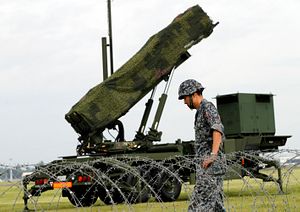On Wednesday, the Japan Air Self-Defense Force (ASDF) conducted a missile defense operations drill in a Tokyo park. According to Japan’s Kyodo news agency, this was the first time in six years that such an exercise had taken place in a “public place” in Japan.
The exercise follows the launch earlier this month of a submarine-launched ballistic missile by North Korea into Japan’s exclusive economic zone. The launch was the first test by North Korea of a strategic, nuclear-capable ballistic missile since November 2017. It was also the first launch of a missile into Japan’s EEZ since that month, when North Korea had tested its Hwasong-15 intercontinental-range ballistic missile for the first time.
“By showing our capability to quickly respond to ballistic missiles, I think we can make people feel secure,” said Lt Col Takasuke Maeda, said, according to Kyodo. His comments suggested that the ASDF exercise was primarily meant to reassure the Japanese public.
The system involved in the exercise was one of Japan’s Patriot Advanced Capability-3 (PAC-3) ASDF units. The PAC-3 is capable of intercepting short- and medium-range ballistic missile targets in their terminal phase of flight within the earth’s atmosphere.
Wednesday’s drill was attended and observed by Japanese Defense Minister Taro Kono and Yuriko Koike, the governor of Tokyo. The last time such a drill was conducted in a public location was in Osaka in 2013, when an ASDF unit simulated PAC-3 operations in a park in Osaka prefecture.
Japan sharply criticized North Korea’s latest launched. “The firing of this missile poses a grave threat to the security of our country,” Kono said after the launch.
“North Korea has been enhancing missile-related technologies and promoting nuclear and missile development programs. We can never overlook a firing like this, which is also a grave problem for international society as well,” Kono added.
Following the collapse of talks this past week in Stockholm between the United States and North Korea, Pyongyang suggested that it could revisit its self-enforced moratorium on the testing of intercontinental and intermediate-range ballistic missiles. In 2017, it launched two Hwasong-12 intermediate-range ballistic missiles over Japanese territory to a splashdown point in the northern Pacific Ocean.
Systems like the PAC-3 are incapable of intercepting intermediate-range ballistic missiles or lofted medium-range ballistic missiles. To address other ballistic missile challenges from North Korea, Japan is in the process of procuring two Aegis Ashore sites, which would be equipped with exoatmospheric interceptor missiles.
































